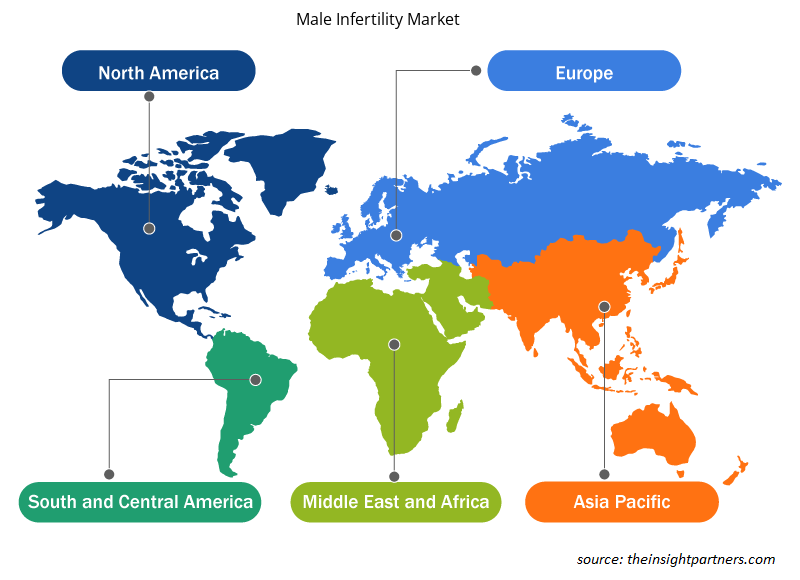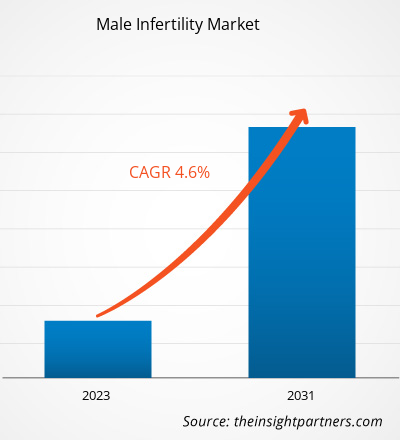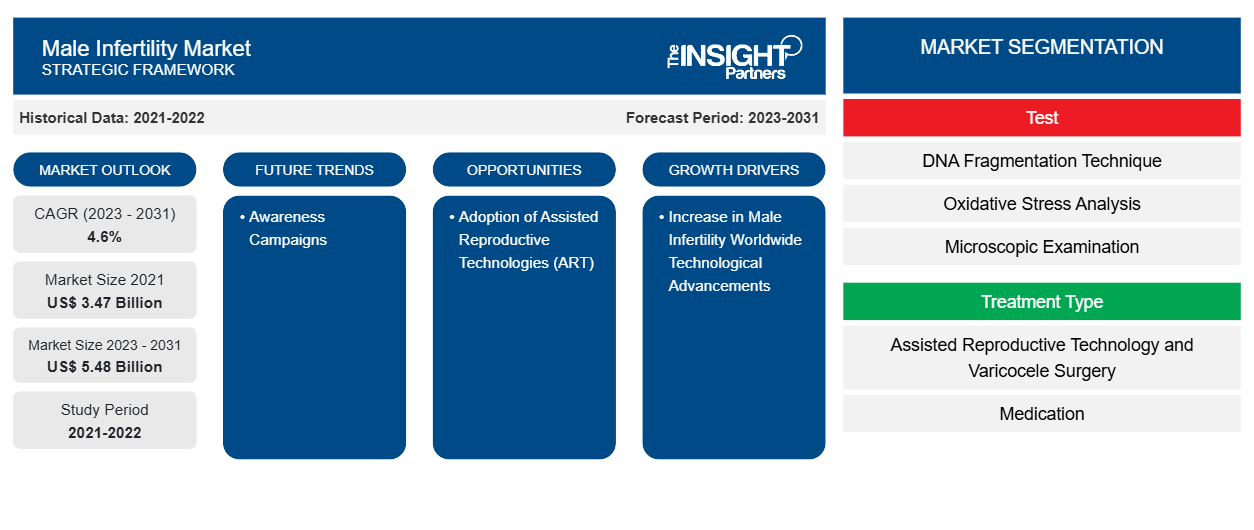Der Markt für männliche Unfruchtbarkeit belief sich 2021 auf 3,47 Milliarden US-Dollar und soll von XX Milliarden US-Dollar im Jahr 2023 auf 5,48 Milliarden US-Dollar im Jahr 2031 anwachsen. Der Markt dürfte zwischen 2023 und 2031 eine durchschnittliche jährliche Wachstumsrate von 4,6 % verzeichnen. Die Einführung assistierter Reproduktionstechnologien (ART) dürfte weiterhin ein wichtiger Markttrend für männliche Unfruchtbarkeit bleiben.
Marktanalyse für männliche Unfruchtbarkeit
Der Markt für männliche Unfruchtbarkeit wächst unter anderem aufgrund steigender Unfruchtbarkeitsraten, der weit verbreiteten Einführung assistierter Reproduktionstechnologie (ART) und technologischer Fortschritte in der ART. Darüber hinaus tragen zunehmender Stress, Fettleibigkeit, Rauchen und Alkoholkonsum zur männlichen Unfruchtbarkeit bei. Darüber hinaus treiben ein größeres Bewusstsein, erhöhte F&E-Ausgaben und veränderte Lebensstile den Markt für männliche Unfruchtbarkeit an.
Marktübersicht für männliche Unfruchtbarkeit
Männliche Unfruchtbarkeit ist ein großes Problem in der modernen Gesellschaft. Unfruchtbarkeit wurde immer als ein weibliches Problem angesehen. Tatsächlich sind jedoch fast die Hälfte aller Unfruchtbarkeitsfälle Männer. Unfruchtbarkeit bei Männern wird am häufigsten durch Probleme wie verringerte Spermienzahl, sinkende Testosteronwerte und steigende Raten von erektiler Dysfunktion und Hodenkrebs verursacht. Darüber hinaus wurde festgestellt, dass Umweltverschmutzung die männliche Fruchtbarkeit, insbesondere die Spermienqualität, beeinflusst.
Passen Sie diesen Bericht Ihren Anforderungen an
Sie erhalten kostenlos individuelle Anpassungen an jedem Bericht, einschließlich Teilen dieses Berichts oder einer Analyse auf Länderebene, eines Excel-Datenpakets sowie tolle Angebote und Rabatte für Start-ups und Universitäten.
-
Holen Sie sich die wichtigsten Markttrends aus diesem Bericht.Dieses KOSTENLOSE Beispiel umfasst eine Datenanalyse von Markttrends bis hin zu Schätzungen und Prognosen.
Markttreiber und Chancen für männliche Unfruchtbarkeit
Weltweiter Anstieg männlicher Unfruchtbarkeit fördert Marktwachstum
Männliche Unfruchtbarkeit bezeichnet die Unfähigkeit eines Mannes, eine fruchtbare Frau schwanger zu machen. Unfruchtbarkeit wird häufig durch Faktoren wie Samenmangel und Samenqualität verursacht. Unfruchtbarkeit bei Männern ist ein weltweit verbreitetes Problem, wobei die Prozentsätze von Region zu Region variieren. Laut einem 2023 von den National Institutes of Health (NIH) veröffentlichten Artikel sind 7 % der männlichen Weltbevölkerung von männlicher Unfruchtbarkeit betroffen. Darüber hinaus wurde festgestellt, dass die Unfruchtbarkeitsraten bei Männern in Afrika und Osteuropa am höchsten sind.
Sensibilisierungskampagnen
Die International Reproductive Health Education Collaboration (IRHEC), früher bekannt als International Fertility Education Initiative, wurde 2021 gegründet. Ihr Ziel ist es, durch Aufklärung das Bewusstsein für Fruchtbarkeit zu fördern. Lehrmaterialien, die die Fruchtbarkeitsgesundheitskompetenz oder das Bewusstsein dafür wirksam fördern, sind von entscheidender Bedeutung, um fundierte Entscheidungen zur Fortpflanzung zu treffen und Subfertilität und Unfruchtbarkeit vorzubeugen und zu behandeln.
Segmentierungsanalyse des Marktberichts zur männlichen Unfruchtbarkeit
Wichtige Segmente, die zur Ableitung der Marktanalyse zur männlichen Unfruchtbarkeit beigetragen haben, sind Test, Behandlungstyp, Vertriebskanal und Endbenutzer.
- Basierend auf Tests ist der Markt für männliche Unfruchtbarkeit in DNA-Fragmentierungstechnik, oxidative Stressanalyse, mikroskopische Untersuchung, Spermienagglutination, computergestützte Spermienanalyse, Spermienpenetrationstest und andere unterteilt. Das Segment DNA-Fragmentierungstechnik hatte im Jahr 2023 einen größeren Marktanteil.
- Nach Behandlungsart ist der Markt in assistierte Reproduktionstechnologie und Varikozele-Operationen sowie Medikamente unterteilt. Das Segment assistierte Reproduktionstechnologie und Varikozele-Operationen hatte im Jahr 2023 den größten Marktanteil.
- Nach Vertriebskanal ist der Markt in Krankenhausapotheken, Apotheken und Drogerien sowie Online-Apotheken unterteilt. Das Segment der Krankenhausapotheken hatte im Jahr 2023 den größten Marktanteil.
- In Bezug auf die Endverbraucher ist der Markt in Krankenhäuser und Kliniken, Fruchtbarkeitszentren, Forschungsinstitute und andere Endverbraucher unterteilt. Das Segment der Fruchtbarkeitszentren dominierte den Markt im Jahr 2023.
Männliche Unfruchtbarkeit Marktanteilsanalyse nach Geografie
Der geografische Umfang des Marktberichts zur männlichen Unfruchtbarkeit ist hauptsächlich in fünf Regionen unterteilt: Nordamerika, Asien-Pazifik, Europa, Naher Osten und Afrika sowie Süd- und Mittelamerika.
Nordamerika dominiert den Markt für männliche Unfruchtbarkeit. Der steigende Konsum von Alkohol und Drogen, steigendes Stressniveau, Fettleibigkeit, Rauchen und Umweltgifte gehören zu den Faktoren, die das Wachstum des nordamerikanischen Marktes für männliche Unfruchtbarkeit voraussichtlich beschleunigen werden. Darüber hinaus wird erwartet, dass das zunehmende Bewusstsein und die Verringerung der Nervosität der Menschen hinsichtlich der Krankheit die Nachfrage nach Behandlungen für männliche Unfruchtbarkeit während des Untersuchungszeitraums ankurbeln werden.
Regionale Einblicke in den Markt für männliche Unfruchtbarkeit
Die regionalen Trends und Faktoren, die den Markt für männliche Unfruchtbarkeit während des Prognosezeitraums beeinflussen, wurden von den Analysten von Insight Partners ausführlich erläutert. In diesem Abschnitt werden auch Marktsegmente und Geografie für männliche Unfruchtbarkeit in Nordamerika, Europa, im asiatisch-pazifischen Raum, im Nahen Osten und Afrika sowie in Süd- und Mittelamerika erörtert.

- Erhalten Sie regionale Daten zum Markt für männliche Unfruchtbarkeit
Umfang des Marktberichts zur männlichen Unfruchtbarkeit
| Berichtsattribut | Details |
|---|---|
| Marktgröße im Jahr 2021 | 3,47 Milliarden US-Dollar |
| Marktgröße bis 2031 | 5,48 Milliarden US-Dollar |
| Globale CAGR (2023 - 2031) | 4,6 % |
| Historische Daten | 2021-2022 |
| Prognosezeitraum | 2023–2031 |
| Abgedeckte Segmente |
Durch Test
|
| Abgedeckte Regionen und Länder |
Nordamerika
|
| Marktführer und wichtige Unternehmensprofile |
|
Dichte der Marktteilnehmer im Bereich männliche Unfruchtbarkeit: Die Auswirkungen auf die Geschäftsdynamik verstehen
Der Markt für männliche Unfruchtbarkeit wächst rasant, angetrieben durch die steigende Endverbrauchernachfrage aufgrund von Faktoren wie sich entwickelnden Verbraucherpräferenzen, technologischen Fortschritten und einem größeren Bewusstsein für die Vorteile des Produkts. Mit steigender Nachfrage erweitern Unternehmen ihr Angebot, entwickeln Innovationen, um die Bedürfnisse der Verbraucher zu erfüllen, und nutzen neue Trends, was das Marktwachstum weiter ankurbelt.
Die Marktteilnehmerdichte bezieht sich auf die Verteilung der Firmen oder Unternehmen, die in einem bestimmten Markt oder einer bestimmten Branche tätig sind. Sie gibt an, wie viele Wettbewerber (Marktteilnehmer) in einem bestimmten Marktraum im Verhältnis zu seiner Größe oder seinem gesamten Marktwert präsent sind.
Die wichtigsten auf dem Markt für männliche Unfruchtbarkeit tätigen Unternehmen sind:
- MERCK KGaA,
- Sanofi,
- Bayer AG,
- Endo Pharmaceuticals Inc.,
- SCSA Diagnostics, Inc.,
- Andrologie-Lösungen,
Haftungsausschluss : Die oben aufgeführten Unternehmen sind nicht in einer bestimmten Reihenfolge aufgeführt.

- Überblick über die wichtigsten Akteure auf dem Markt für männliche Unfruchtbarkeit
Neuigkeiten und aktuelle Entwicklungen zum Markt für männliche Unfruchtbarkeit
Der Markt für männliche Unfruchtbarkeit wird durch die Erhebung qualitativer und quantitativer Daten nach Primär- und Sekundärforschung bewertet, die wichtige Unternehmensveröffentlichungen, Verbandsdaten und Datenbanken umfasst. Im Folgenden finden Sie eine Liste der Entwicklungen auf dem Markt für männliche Unfruchtbarkeit:
- Sidra Medicine hat im Rahmen seiner Expansion privater Reproduktionsmedizindienste in Katar eine neue Klinik für männliche Unfruchtbarkeit eröffnet. (Quelle: Sidra Medicine, Newsroom, 2022)
- Merck, ein führendes Wissenschafts- und Technologieunternehmen, gab heute bekannt, dass die Europäische Kommission (EK) die Marktzulassung (MA) für seinen neuen GONAL-f (Follitropin alfa) 150 IE Pen erteilt hat. Dies bedeutet, dass Merck jetzt ein noch umfassenderes Sortiment erstklassiger Pens anbietet, die Patienten vom Beginn bis zum Ende ihres Fruchtbarkeitsstimulationszyklus unterstützen, wenn niedrigere Dosen erforderlich sind. (Quelle: Merck KGaA, Pressemitteilung, 2020)
Marktbericht zur männlichen Unfruchtbarkeit – Abdeckung und Ergebnisse
Der Bericht „Marktgröße und Prognose zur männlichen Unfruchtbarkeit (2021–2031)“ bietet eine detaillierte Analyse des Marktes, die die folgenden Bereiche abdeckt:
- Marktgröße und Prognose auf globaler, regionaler und Länderebene für alle wichtigen Marktsegmente, die im Rahmen des Projekts abgedeckt sind
- Marktdynamik wie Treiber, Beschränkungen und wichtige Chancen
- Wichtige Zukunftstrends
- Detaillierte PEST/Porters Five Forces- und SWOT-Analyse
- Globale und regionale Marktanalyse mit wichtigen Markttrends, wichtigen Akteuren, Vorschriften und aktuellen Marktentwicklungen
- Branchenlandschaft und Wettbewerbsanalyse, einschließlich Marktkonzentration, Heatmap-Analyse, prominenten Akteuren und aktuellen Entwicklungen
- Detaillierte Firmenprofile
- Historische Analyse (2 Jahre), Basisjahr, Prognose (7 Jahre) mit CAGR
- PEST- und SWOT-Analyse
- Marktgröße Wert/Volumen – Global, Regional, Land
- Branchen- und Wettbewerbslandschaft
- Excel-Datensatz
Aktuelle Berichte
Erfahrungsberichte
Grund zum Kauf
- Fundierte Entscheidungsfindung
- Marktdynamik verstehen
- Wettbewerbsanalyse
- Kundeneinblicke
- Marktprognosen
- Risikominimierung
- Strategische Planung
- Investitionsbegründung
- Identifizierung neuer Märkte
- Verbesserung von Marketingstrategien
- Steigerung der Betriebseffizienz
- Anpassung an regulatorische Trends























 Kostenlose Probe anfordern für - Markt für männliche Unfruchtbarkeit
Kostenlose Probe anfordern für - Markt für männliche Unfruchtbarkeit